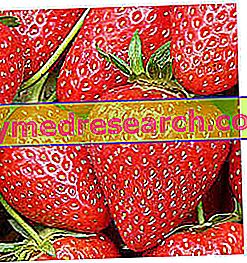Generality
Strawberries are the fruit - more correctly the false fruit or conocarp in botanical terms - of plants belonging to the Rosaceae family and the genus Fragaria . The most common type of strawberry is Fragaria x ananassa or strawberry from a vegetable garden / garden, obtained by crossing the North American Fragaria virginiana and the Fragaria chiloensis or Chilean.

Strawberries are small fruits (about 8-10 times smaller than an apple but 3-4 times larger than a blackberry); when fully ripe they are bright red and yellowish-greenish pigmented (color conferred by the numerous and small external achenes, commonly mistaken for seeds * ). The aroma and taste (sweet) of strawberries are characteristic and make them one of the most appreciated and marketed fruits on the entire planet.
Strawberries can be consumed fresh, frozen, dried, jam, blended, canned and as fruit juice or liquid syrup; in addition, they are an ingredient widely used in the formulation of ice cream, cakes and desserts. I notice the combination of strawberries and chocolate or between strawberries and whipped cream.
Notes on cultivation
The various subspecies and varieties of cultivated strawberries vary from one another in: size of the fruit, color, taste, shape, degree of fertility, season of maturation, resistance to disease and constitution of the plant. In most strawberries the flowers appear hermaphrodites, but their function is only male or female, never both. Generally, strawberries are NEVER produced by sowing (not convenient), but by transplanting "children", that is, branches that start from the mother plant and develop roots. The procedure can be of an annual plastic culture (with plowing at the end of each season) or perennial, with the severing and re-use of the "children". There is also a lower production in the greenhouse during the winter period.
The use of fertilizers (nitrogen, phosphorus and potassium) is always necessary, and applied in two very distinct moments: at the end of the production cycle and before the beginning of the following. The most dangerous parasites for strawberries are: snails, moths, fruit flies, beetles, mites and aphids; the most common fungal diseases of the leaves are instead: powdery mildew, rust, perenospora and mucilaginous molds, while the fruits can be attacked by gray mold and verticillum and nematodes roots.
| Nutritional composition of Strawberries - Reference values of the INRAN Food Composition Tables | ||||||||||||||||||||||||||||||||||||||||||||||||||||||||||||||||||||||||
 | ||||||||||||||||||||||||||||||||||||||||||||||||||||||||||||||||||||||||
Nutritional values (per 100 g of edible portion) | ||||||||||||||||||||||||||||||||||||||||||||||||||||||||||||||||||||||||
| ||||||||||||||||||||||||||||||||||||||||||||||||||||||||||||||||||||||||
The strawberries are picked by hand, together with the complete ripening, better if on alternate days and taking care to remove the rotten fruits from the plants.
The "heads" of the strawberries must remain firmly attached to the fruit being harvested.
Consumption and nutritional characteristics
Strawberries are fruits with a modest calorific value; they mainly supply simple sugars (fructose) and the amount of proteins and fats is negligible. The amount of fiber and water is considerable.
From the saline point of view, strawberries contain excellent amounts of potassium and manganese, while as far as vitamins are concerned there are significant concentrations of folic acid and ascorbic acid (vit C). This last molecule is one of the main antioxidant constituents of strawberries, whose power is well supported by flavonoids (polyphenols), in particular by fisetin . It is a flavonol pigmentosa widely studied by the scientific community in various pathological contexts; the interaction between the strawberries and the human body has been observed in case of: Alzheimer's disease, type 2 diabetes mellitus, hypercholesterolemia, etc. The results are still being clarified but it is likely that it can boast properties: antiaging, anti-cancer, antioxidants, anti-inflammatory and antiviral; however, it cannot be excluded that it may hide side effects such as an increased risk of disease in the fetus (such as leukemia, due to interaction with nucleic acids).
Strawberries are also potentially allergenic foods; this form of hypersensitivity (rather widespread) usually occurs with cutaneous and oral mucosa symptoms, more rarely with hay fever, dermatitis, hives and respiratory problems. The "theoretically" active principle responsible for the adverse reactions is Fragaria allergen 1, a protein also present in apple and birch, plants that show a concrete cross-reactivity of subjects allergic to strawberries. In this regard, a particular cultivation ( Sofar ) has been differentiated which produces strawberries without Fragaria allergen1 ; this plant produces fully white ripe fruits (since they do not contain flavonoids) and its peculiar aspect is also advantageous in the fight against avian infesters in open field cultivation.
Recipes with Strawberries
On the site, you can find dozens of recipes with strawberries, such as homemade strawberry jam, strawberry ice cream and strawberry tiramisu, of which below we propose the video recipe.



